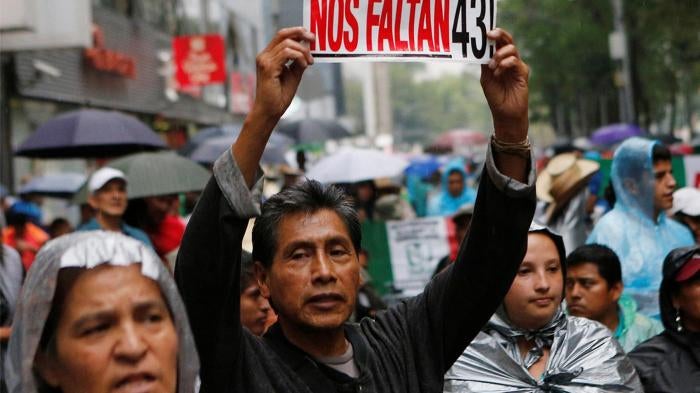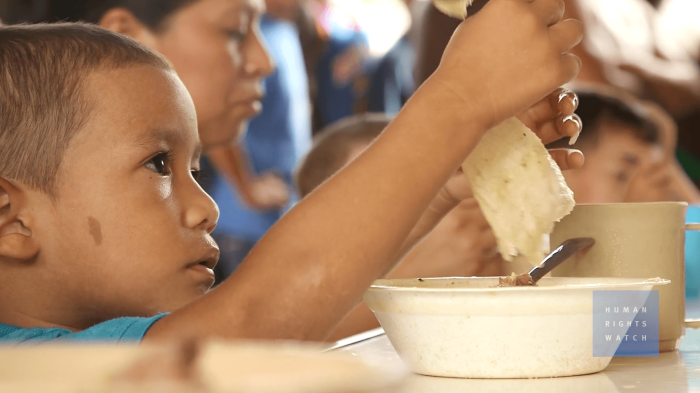During the administration of President Enrique Peña Nieto, security forces have been implicated in repeated, serious human rights violations—including extrajudicial killings, enforced disappearances, and torture—during efforts to combat organized crime. The government has made little progress in prosecuting those responsible for recent abuses, let alone the large number of abuses committed by soldiers and police since former President Felipe Calderón (2006-2012) initiated Mexico’s “war on drugs.”
In April, the Interdisciplinary Group of Independent Experts (GIEI), which was established through an agreement between the government and the Inter-American Commission on Human Rights (IACHR), issued its final report on the case of the 43 disappeared students from Ayotzinapa, Guerrero State. The report documented egregious flaws in the government’s investigation of the case, refuted key conclusions by the Attorney General’s Office, and called on authorities to pursue fresh lines of investigation. Other continuing problems in Mexico include attacks on journalists and limited access to reproductive rights and health care.
Enforced Disappearances
Since 2006, Mexico’s security forces have participated in widespread enforced disappearances.
In August 2016, the government reported that the whereabouts of more than 27,000 people who had gone missing since 2006 remain unknown. Prosecutors and police routinely fail to take basic investigative steps to identify those responsible for enforced disappearances, often telling the missing people’s families to investigate on their own. Authorities have failed to identify remains of bodies or body parts found in various locations, including in clandestine graves, throughout the country.
The federal government has pursued potentially promising initiatives to find people who have gone missing, but they have produced limited results. In 2013, it created a unit in the Attorney General’s Office to investigate disappearances, which became a Special Prosecutor’s Office in October 2015. However, when consulted in April, members of that office said that they had brought charges in only four of a total of 830 cases of disappearances into which they had opened investigations.
In 2015, Congress approved a constitutional reform giving it authority to pass general laws on enforced disappearance and torture that would establish a single nationwide definition for each of the crimes and facilitate their prosecution in all 31 states and Mexico City. At time of writing, President Peña Nieto had submitted the bills to Congress but neither had been enacted.
Only one of the 43 missing students from the teachers college in Ayotzinapa, disappeared in 2014 and believed killed, has been positively identified among remains that the government says are those of the students. As of July, more than 100 people had been charged with alleged involvement in the abductions and killings; at time of writing, none had been convicted.
Extrajudicial Killings
Unlawful killings of civilians by Mexican security forces “take place at an alarmingly high rate” amid an atmosphere of “systematic and endemic impunity,” according to the United Nations special rapporteur on extrajudicial, summary, or arbitrary executions in 2014.
In August 2016, the National Human Rights Commission (CNDH) concluded that federal police arbitrarily executed 22 of 42 civilians who died in a confrontation in 2015 in Tanhuato, Michoacán State. Police fatally shot at least 13 people in the back, tortured two detainees, and burned a man alive, the CNDH concluded, then altered the crime scene by moving bodies and planting guns to justify the illegal killings.
At time of writing, a federal investigation into the Tanhuato killings remained open.
Military Abuses and Impunity
Mexico has relied heavily on the military to fight drug-related violence and organized crime, leading to widespread human rights violations by military personnel. As of July, the CNDH had received almost 10,000 complaints of abuse by the army since 2006—including more than 2,000 during the current administration. It found in more than 100 cases that military personnel committed serious human rights violations.
In 2014, Congress reformed the Code of Military Justice to require that abuses committed by members of the military against civilians be handled by the civilian criminal justice system rather than the military system, which had a history of routinely failing to hold members of the military accountable for abuses. Under the reform, abuses committed by military personnel against other soldiers remain subject to military justice.
In May 2016, provisions included in a new Military Code of Criminal Procedure and in reforms to the Code of Military Justice granted military prosecutors and judges broad powers to search homes and public buildings, and to listen to private telecommunications, without a judicial order issued by a civilian judge. In June, the CNDH challenged the constitutionality of these provisions, and at time of writing a Supreme Court decision was pending.
In the case of Tlatlaya, where soldiers killed 22 civilians in 2014—witnesses and the CNDH reported that they extrajudicially executed at least 12 of them—nobody has been convicted of the killings. In May 2016, a civilian, federal court absolved the last of eight soldiers charged with homicide at Tlatlaya.
Torture
Torture is widely practiced in Mexico to obtain confessions and extract information. It is most frequently applied in the period between when victims are detained, often arbitrarily, and when they are handed over to civilian prosecutors, a period in which they are often held incommunicado at military bases or illegal detention sites. Common torture techniques include beatings, waterboarding, electric shocks, and sexual abuse.
In its second report on the Ayotzinapa case, the Interdisciplinary Group of Independent Experts, established through an agreement between the government and the Inter-American Commission on Human Rights (IACHR), concluded that 80 percent of the suspects detained in connection with the case showed bodily injuries possibly due to ill treatment and torture.
According to the CNDH, Mexico State prosecutors sought to cover up military wrongdoing in the Tlatlaya case by using torture to coerce false testimony from witnesses. In July, authorities said they would fire seven or eight investigators and suspend 22 others—for as little as a month—for misconduct, but nobody has been convicted in connection with the cover-up.
Despite a constitutional prohibition on using evidence obtained through torture, some judges continue to disregard torture complaints and accept allegedly coerced confessions.
Criminal Justice System
The criminal justice system routinely fails to provide justice to victims of violent crimes and human rights violations. Causes of failure include corruption, inadequate training and resources, and complicity of prosecutors and public defenders with criminals and abusive officials. The failure of law enforcement has contributed to the emergence of armed citizen self-defense groups in several parts of the country.
In 2013, Mexico enacted a federal Victims Law intended to ensure justice, protection, and reparations for crime victims. After Senate approval in November 2016, reforms to the law, intended to reduce bureaucracy and improve access to aid and reparations for victims, moved to the Chamber of Deputies for consideration.
Freedom of Media
Journalists, particularly those who report on crime or criticize officials, face harassment and attacks. Journalists are often driven to self-censorship by attacks by authorities or criminal groups.
The Attorney General’s Office documented 124 killings of journalists from 2000 through July 2016. The nongovernmental organization (NGO) Article 19 documented seven cases of journalists killed from January through June 2016.
By April 2016, 509 people had requested protection under a 2012 law to protect human rights defenders and journalists. Protection has been slow to arrive or, in some cases, insufficient. At time of writing, authorities had yet to bring charges under the law against anyone believed responsible for threats or attacks.
Authorities routinely fail to investigate crimes against journalists adequately, often preemptively ruling out their profession as a motive. The CNDH reported in 2016 that 90 percent of crimes against journalists in Mexico go unpunished, including 82 percent of killings and 100 percent of disappearances. The Special Prosecutor’s Office for Crimes against Freedom of Expression, created in 2006, had by April 2016 opened 790 preliminary investigations, concluded 633, and brought charges in 93, none of them involving disappearances or homicides.
Unaccompanied Migrant Children
Mexican immigration authorities apprehended more than 20,000 unaccompanied children from El Salvador, Guatemala, and Honduras in 2015 and more than 14,000 in the first ten months of 2016, detaining the vast majority. Many fled persecution and violence, and as many as half may have had strong cases for asylum, according to the Office of the United Nations High Commissioner for Refugees. Yet Mexico’s refugee agency, the Mexican Commission for Refugee Assistance (Comisión Mexicana de Ayuda a Refugiados, COMAR), afforded international protection to just 57 unaccompanied children from these countries in 2015 and 96 in the first 10 months of 2016, less than 1 percent of the total number of unaccompanied children apprehended in these periods. The discrepancy between the large number of unaccompanied children with plausible claims and the very small number who apply for and receive asylum is due partly to the fact that many immigration enforcement officers are ill-equipped and disinclined to evaluate children’s protection needs and instead focus on detention and deportation.
In October, President Enrique Peña Nieto announced that Mexico would strengthen its refugee recognition procedures and “develop alternatives to immigration detention for asylum seekers, particularly children.” These changes had not been implemented at time of writing.
Women’s and Girls’ Rights
Mexican laws do not adequately protect women and girls against domestic and sexual violence. Some provisions, including those that make the severity of punishments for some sexual offenses contingent upon the “chastity” of the victim, contradict international standards.
Eighteen states have passed laws establishing that there is a right to life from the moment of conception. Although the Supreme Court ruled in 2010 that all states must provide emergency contraception and access to abortion for rape victims, many women and girls face serious barriers to accessing abortions after sexual violence, including official intimidation.
Sexual Orientation and Gender Identity
Same-sex marriage has been legal in Mexico City since 2010. Since then, nine states have legalized it; in 2015, the Supreme Court opened the door to recognition in all states by ruling that the definition of marriage as a union only between a man and a woman constitutes discrimination and thus violates Mexico's Constitution.
In May 2016, President Peña Nieto introduced a bill to legalize same-sex marriage, to remove sexual orientation and gender identity as barriers to adoption, and to recognize gender identity through the reissuance of birth notices, without a doctor’s involvement. Two committees in the Chamber of Deputies voted against the initiative in November.
Palliative Care
The lack of access to palliative care results in needless suffering for large numbers of Mexicans with serious illnesses. In 2016, the National Commission for Social Protection in Health added palliative care as a covered health service under Seguro Popular, a public health insurance scheme that covers more than 55 million people. By late 2016, more than 2,000 physicians were using the new system, introduced in mid-2015, for prescribing strong pain medicines. Despite such strides, obstacles remain, including a paucity of facilities offering palliative care in many states.
Disability Rights
The UN Committee on the Rights of Persons with Disabilities, in a 2014 report, found that, despite new laws and programs protecting the rights of the disabled, serious gaps remained, including in access to justice, legal standing, and the right to vote; access to buildings, transportation, and public spaces; violence against women; and education.
In 2015, Disability Rights International reported that Mexican women with psychosocial disabilities were at high risk of being denied reproductive rights; that state-run clinics in Mexico City sometimes pressured them into being sterilized or, when pregnant, undergoing abortion; and that conditions were inhumane in Mexico City’s government-funded facilities for people with disabilities, including one institution that locked children in cages.
Key International Actors
The IACHR published a report in March documenting a wide range of abuses in Mexico—including disappearances; extrajudicial executions; torture; and insecurity for women, children, migrants, human rights defenders, and journalists—which they concluded amounted to a “crisis of gross human rights violations.” The government criticized the report, responding that there was no “human rights crisis” in Mexico. Later that month, Mexican authorities denied UN Special Rapporteur on Torture Juan Méndez permission to return before the end of his term. In 2015, authorities had rejected Méndez’s conclusion that torture was widespread and accused him of acting “unethically.”
In April, the UN special rapporteurs on human rights defenders, freedom of expression, and freedom of assembly and association expressed concern regarding a targeted campaign in the Mexican media accusing human rights defenders and civil society organizations of fraud, corruption, and the promotion of impunity through allegedly false claims about detainees being tortured. They urged the government to ensure “a safe environment” in which such individuals and organizations could operate “free of harassment.”
In October, the Office of the UN High Commissioner for Human Rights issued 14 recommendations to Mexico on the need to address impunity for human rights violations, adopt laws to regulate the use of force and eliminate torture and enforced disappearances, and establish an independent forensic institution with adequate resources. In May, the UN special rapporteur on extrajudicial, summary, or arbitrary executions released a report on Mexico identifying continuing serious violations, including extrajudicial killings and excessive use of force by security forces, impunity, and lack of reparations for victims. The UN Committee on Enforced Disappearances has issued dozens of urgent actions on cases in Mexico since 2012.
In September, the IACHR referred to the Inter-American Court of Human Rights the case of 11 women who were arrested at a protest of flower growers in Mexico State in 2006, when President Peña Nieto was governor there. The commission described their arrest as “illegal and arbitrary” and said it “considered it proved” that state agents subjected the women to physical and psychological torture and raped seven of them. The Inter-American Court is scheduled to hear the case in 2017.
Since 2007, the United States has allocated more than US$2 billion in aid through the Merida Initiative to help combat organized crime. In 2015, the US secretary of state withheld $5 million in security aid, saying the State Department could not confirm that Mexico had met the agreement’s human rights criteria, but in September 2016 certified that Mexico had made sufficient human rights progress to justify receiving its full Mérida aid of about $155 million.







